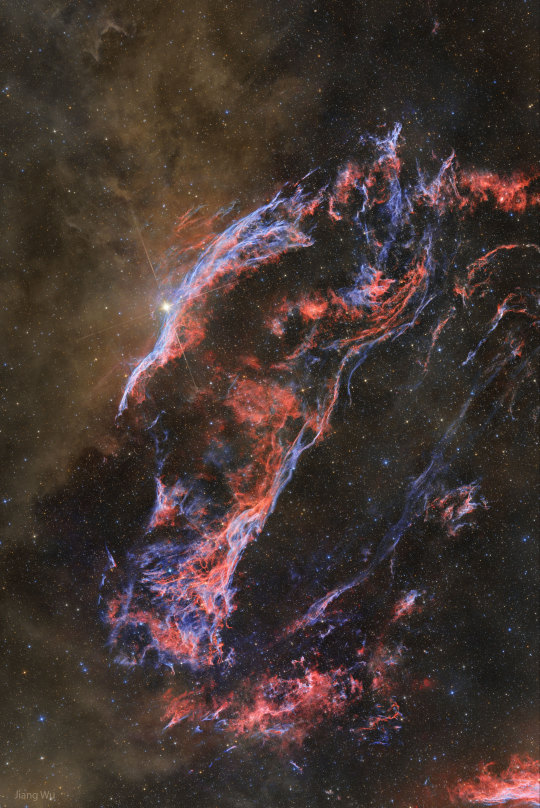#western veil nebula
Text

The Western Veil Nebula, NGC 6960 // Karl-Heinz Macek
The bright star is 52 Cygni which is in the foreground and unrelated to the nebula.
#astronomy#astrophotography#nebula#emission nebula#diffuse nebula#supernova remnant#veil nebula#western veil nebula#NGC 6960#star#giant star#52 cygni#cygnus
550 notes
·
View notes
Text

All Along The Western Veil
10K notes
·
View notes
Text

Western Veil Nebula l NASA APOD
#space#astrophotography#astronomy#nasa#apod#universe#veil nebula#stars#night#galaxy#solar system#planets#sky
716 notes
·
View notes
Photo
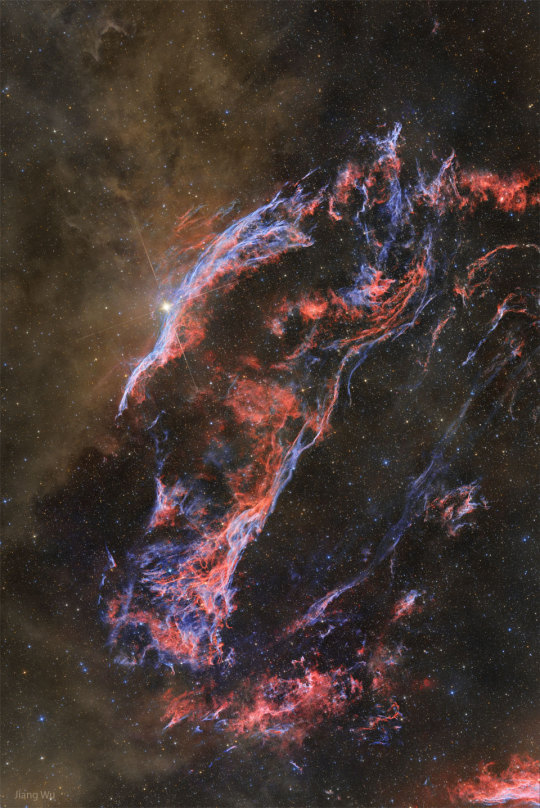
2023 October 18
Dust and the Western Veil Nebula
Image Credit & Copyright: Jiang Wu
Explanation: It's so big it is easy to miss. The entire Veil Nebula spans six times the diameter of the full moon, but is so dim you need binoculars to see it. The nebula was created about 15,000 years ago when a star in the constellation of the Swan (Cygnus) exploded. The spectacular explosion would have appeared brighter than even Venus for a week - but there is no known record of it. Pictured is the western edge of the still-expanding gas cloud. Notable gas filaments include the Witch's Broom Nebula on the upper left near the bright foreground star 52 Cygni, and Fleming's Triangular Wisp (formerly known as Pickering's Triangle) running diagonally up the image middle. What is rarely imaged -- but seen in the featured long exposure across many color bands -- is the reflecting brown dust that runs vertically up the image left, dust likely created in the cool atmospheres of massive stars.
∞ Source: apod.nasa.gov/apod/ap231018.html
232 notes
·
View notes
Text
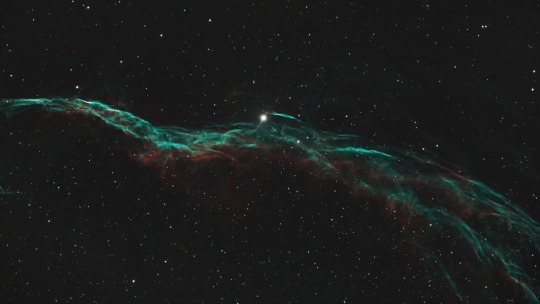
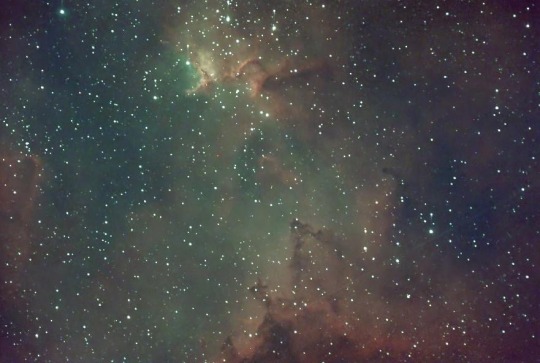
Processing old data on a cloudy night. The Western Veil and a close up of the inside of the Heart Nebula.
212 notes
·
View notes
Photo

NGC 6995: The Bat Nebula : Do you see the bat? It haunts this cosmic close-up of the eastern Veil Nebula. The Veil Nebula itself is a large supernova remnant, the expanding debris cloud from the death explosion of a massive star. While the Veil is roughly circular in shape and covers nearly 3 degrees on the sky toward the constellation of the Swan (Cygnus), NGC 6995, known informally as the Bat Nebula, spans only 1/2 degree, about the apparent size of the Moon. That translates to 12 light-years at the Veil's estimated distance, a reassuring 1,400 light-years from planet Earth. In the composite of image data recorded through narrow band filters, emission from hydrogen atoms in the remnant is shown in red with strong emission from oxygen atoms shown in hues of blue. Of course, in the western part of the Veil lies another seasonal apparition: the Witch's Broom Nebula. via NASA
2K notes
·
View notes
Text

NGC 6357,
Also referred to as the Lobster Nebula, resides near NGC 6334 in the Scorpius constellation. Within its expanse, numerous proto-stars are veiled by dense gas disks, while young stars are enveloped in expanding gases resembling “cocoons.”
Dubbed the War and Peace Nebula by scientists, its infrared imagery depicts a dove-like figure in the western region and a skull-like appearance in the east.
Despite a failed attempt to rename it the Madokami Nebula, NGC 6357 remains a captivating celestial wonder.
#art#cosmos#cosmic#universe#blast#space#wallpaper#stars#nebula#lobster nebula#NGC 6334#scorpius#constellation#proto-star#war&peace#infrated#imagery#madokami
71 notes
·
View notes
Text

The Western Veil Nebula is a supernova remnant consisting of oxygen, sulfur, and hydrogen gas. This area of Cygnus is densely populated with stars and includes regions of heated gas that make up the Cygnus Loop.
2 notes
·
View notes
Photo
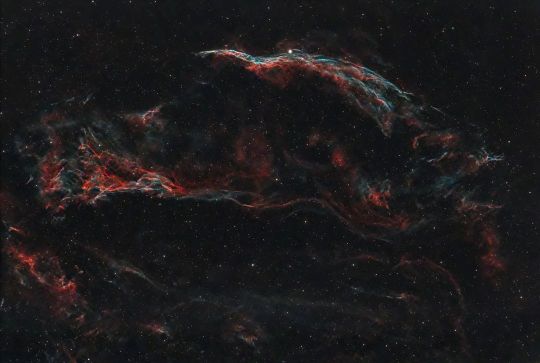
Western Veil Nebula - NGC 6960 Also known as the Witch's Broom, it's centered on the star 52 Cygni. This was part two of my bright moon test, this time getting just over 4.5 hours during a full moon. Because the moon was so bright, I had to cut my exposure time down from 600s to 300s. . 53 x 300s Gain 100, Offset 50 Bin 1x1 Cooling: 0 degrees Celsius Dark, flat, bias and dark flats used for calibration. Images captured in N.I.N.A., stacked in DeepSkyStacker and processed in Photoshop Providence, RI - Bortle 8 . @meadeinstruments Series 6000 80mm Triplet APO @zwoasi ASI2600MC-PRO Antlia ALP-T 5nm Dual Narrowband filter Ho-Tech Field Flattener Sky Watcher EQ6-R Pro ZWO 30mm f4 MiniScope (guide) ZWO asi120mm-mini (guide) . @provjournal . . . #astrophotography #astronomy #phototography #highpointscientific #OPTeam #myOPTgear #agenaastro #astromaniacmag #antliafilters #goldenfilter #zwoasi #zwoasi2600mcpro #westernveilnebula #veilnebula #ngc6960 #52cygni #space #nasa #nebula #Cygnus #nature #spaceimage #nightsky #igworldclub_astrophotography #ig_spaceimage #ig_astrophotography #astrobackyard #backyardastronomy #rhodeisland #earliestlight (at Providence, Rhode Island) https://www.instagram.com/p/CihZNCVuZqG/?igshid=NGJjMDIxMWI=
#astrophotography#astronomy#phototography#highpointscientific#opteam#myoptgear#agenaastro#astromaniacmag#antliafilters#goldenfilter#zwoasi#zwoasi2600mcpro#westernveilnebula#veilnebula#ngc6960#52cygni#space#nasa#nebula#cygnus#nature#spaceimage#nightsky#igworldclub_astrophotography#ig_spaceimage#ig_astrophotography#astrobackyard#backyardastronomy#rhodeisland#earliestlight
6 notes
·
View notes
Text

APOD October 18, 2023
Dust and the Western Veil Nebula
It's so big it is easy to miss. The entire Veil Nebula spans six times the diameter of the full moon, but is so dim you need binoculars to see it. The nebula was created about 15,000 years ago when a star in the constellation of the Swan (Cygnus) exploded. The spectacular explosion would have appeared brighter than even Venus for a week - but there is no known record of it. Pictured is the western edge of the still-expanding gas cloud. Notable gas filaments include the Witch's Broom Nebula on the upper left near the bright foreground star 52 Cygni, and Fleming's Triangular Wisp (formerly known as Pickering's Triangle) running diagonally up the image middle. What is rarely imaged -- but seen in the featured long exposure across many color bands -- is the reflecting brown dust that runs vertically up the image left, dust likely created in the cool atmospheres of massive stars.
©
Jiang Wu
1 note
·
View note
Text
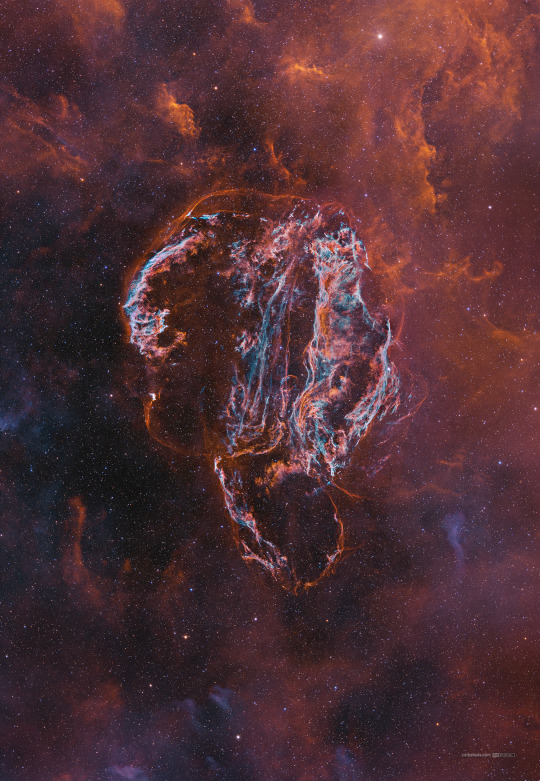
The Cygnus Loop, Sh2-103 // Jose Carballada
#astronomy#astrophotography#nebula#emission nebula#supernova remnant#cygnus loop#veil nebula#western veil nebula#eastern veil nebula#pickering's triangle#Sh2-103#NGC 6960#NGC 6992#NGC 6995#IC 1340#NGC 6974#NGC 6979#cygnus
101 notes
·
View notes
Text
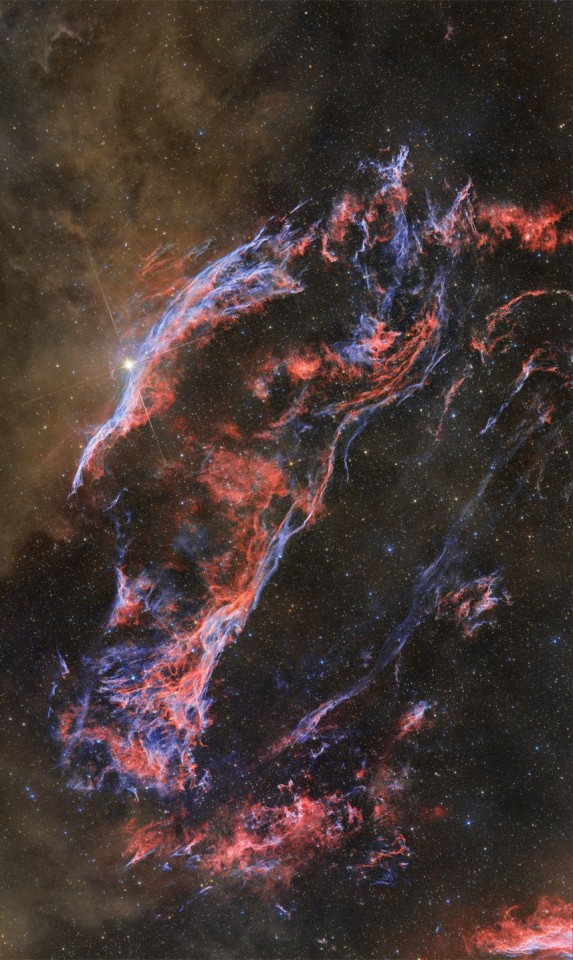
Dusty Western Veil
3K notes
·
View notes
Text
Messier in Crete
Messier catalogued most of the deep space objects we can still watch nowadays in dark night skies like in Crete. Pictures shot with D800, Skyguider Pro tracking system and William Optics 61/360 ZS61 II. Exposure times 150 seconds, ISO 3200.
North America on the left and Pelican nebula (NGC 7000) on the right
Lagoon nebula (M8) in Sagittarius
Western Veil and Eastern veil of Cygnus (NGC…

View On WordPress
#3 weeks in Crete#artborghi photography zurich#astrophotography in greece#greek night skies#lorenzo borghi photographer zurich
0 notes
Photo
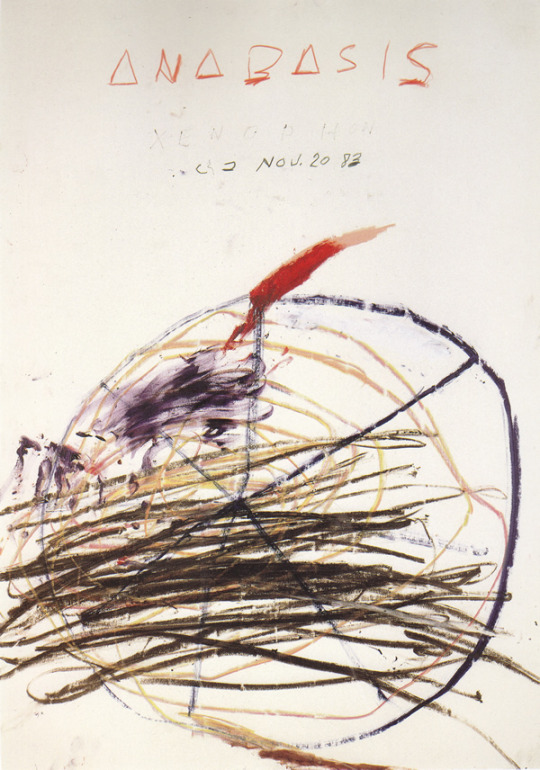
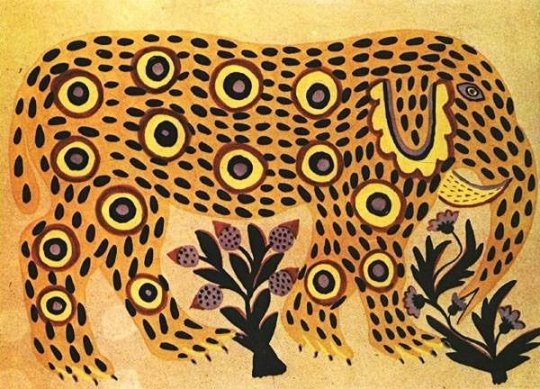
( via / via )
"What we’ve seen instead is a deep dive into apathy."
"We might call this confused, hazy state 'melancholy,' or perhaps we should call it by its Turkish name, hüzün, which denotes a melancholy that is communal rather than private. Offering no clarity, veiling reality instead, hüzün brings us comfort, softening the view like the condensation on a window when the teakettle has been spouting steam on a winter's day. ...If hüzün has been central to İstanbul culture, poetry, and everyday life over the past two centuries, if it dominates our music, it must be at last partly because we see it as an honor...conveying worldly failure, listlessness, and spiritual suffering...the city itself becomes the very illustration, the very essence of hüzün. ...in İstanbul the remains of a glorious past civilization are everywhere visible. ...The people of İstanbul simply carry on with their lives amid the ruins. Many western writers and travelers find this charming. But for the city's more sensitive and attuned residents, these ruins are reminders that the present city is so poor and confused that it can never again dream of rising to its former heights of wealth, power, and culture. ...Hüzün rises out of the pain they feel for everything that has been lost, but it is also what compels them to invent new defeats and new ways to express their impoverishment." --Orhan Pamuk, İstanbul (2004)
Loch Modan.
cicadas emerge
into a changed world · same song
to the heat they fling
soviet cosmonaut finds
on his return no country
"...a close stellar pass that occurred 70,000 years ago may have left traces we can still see in the orbits of these minor Solar System bodies today."
"The pain of life is much more powerful than the interest in life. That's why religion will always conquer philosophy." --V V Rozanov, Solitaria (tr E Gollerbach, 1927)
Nebula Sanctuary.
0 notes
Text
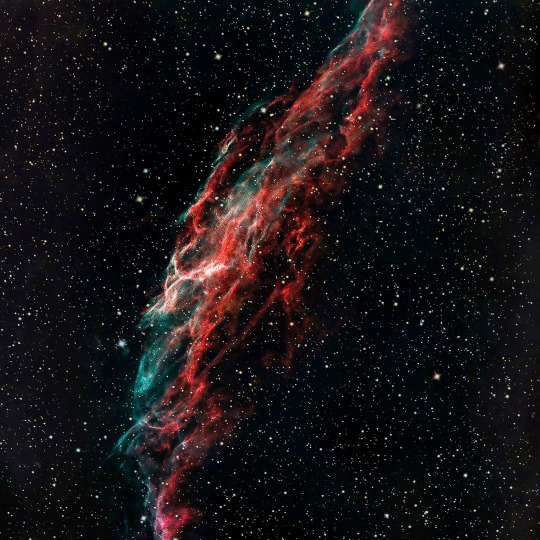
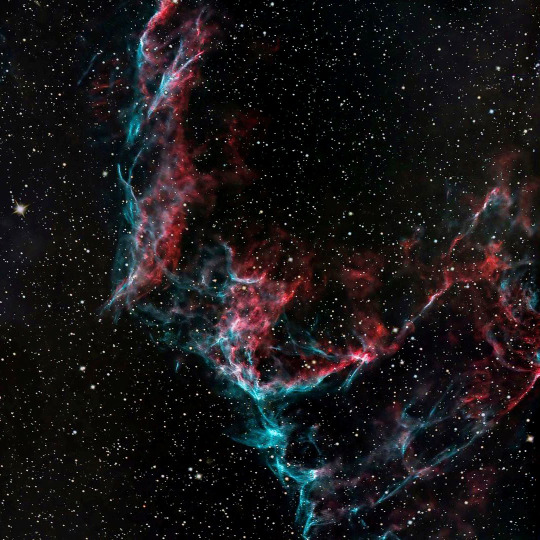
The finger of God; Western Veil ll starpunker
#western veil nebula#ngc 6960#nasa#witch's broom#stars#supernova#astronomy#astrophotography#galaxies#solar system#planets#galaxy#planet#Veil#nebula
595 notes
·
View notes
